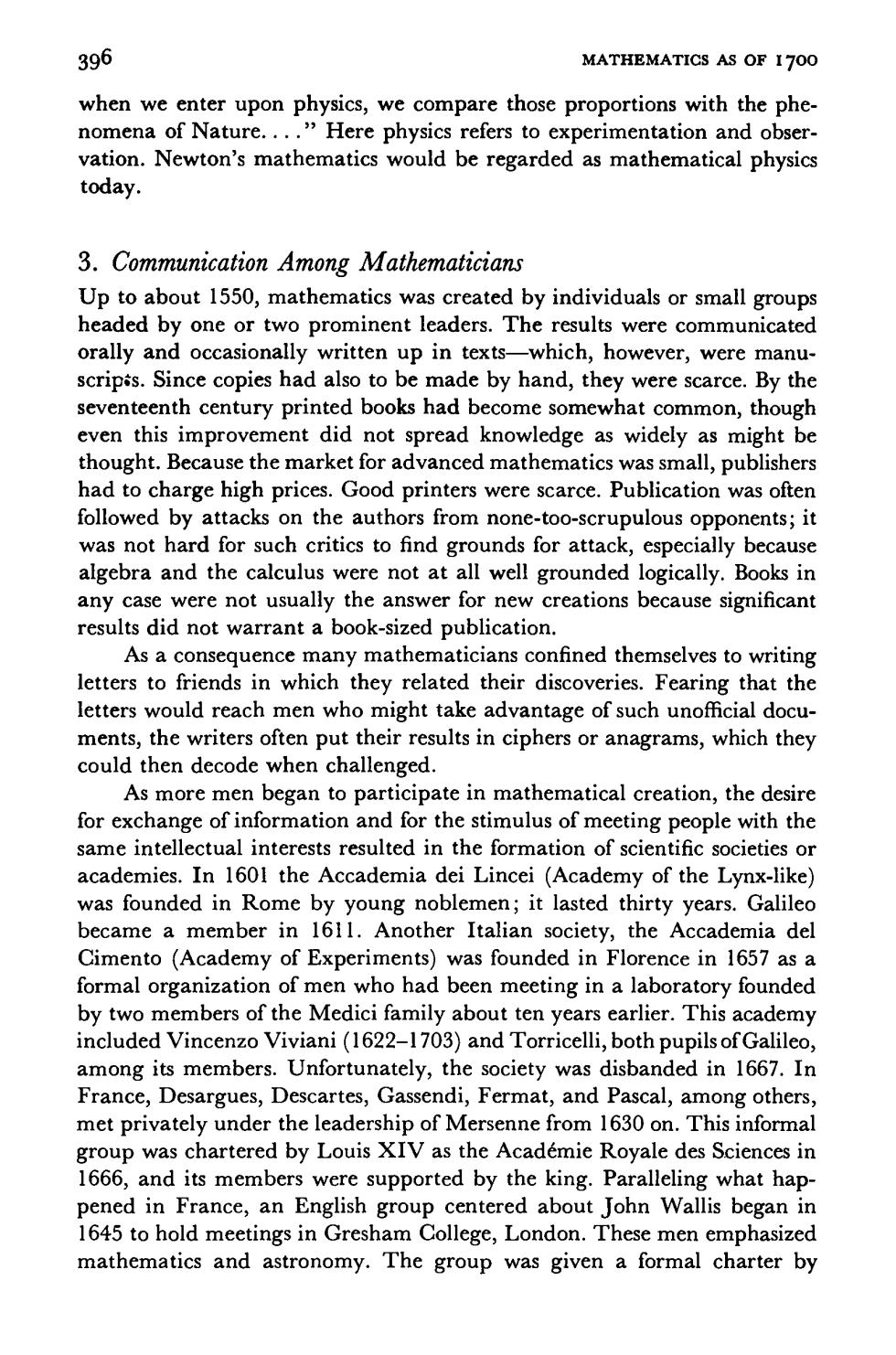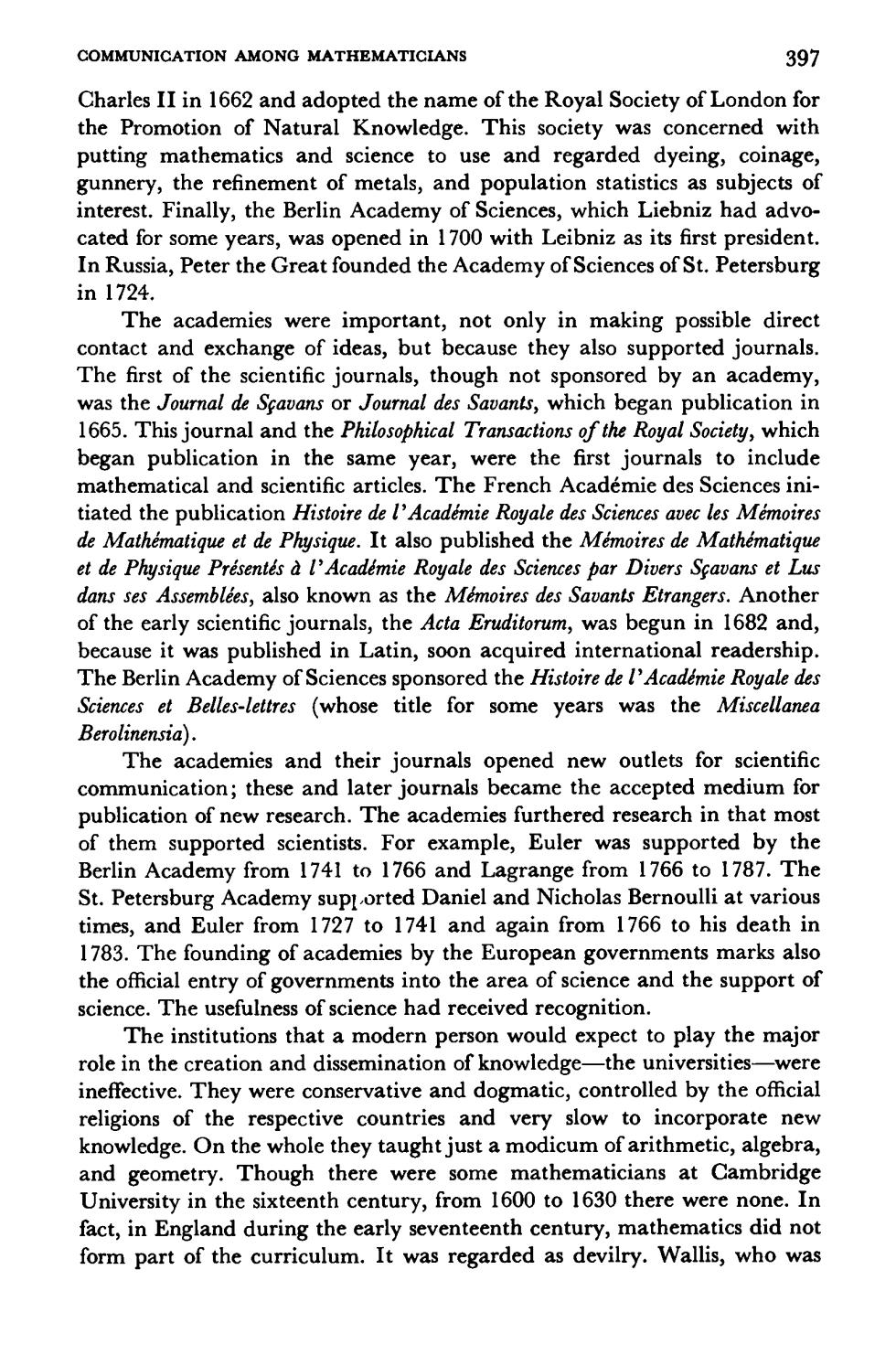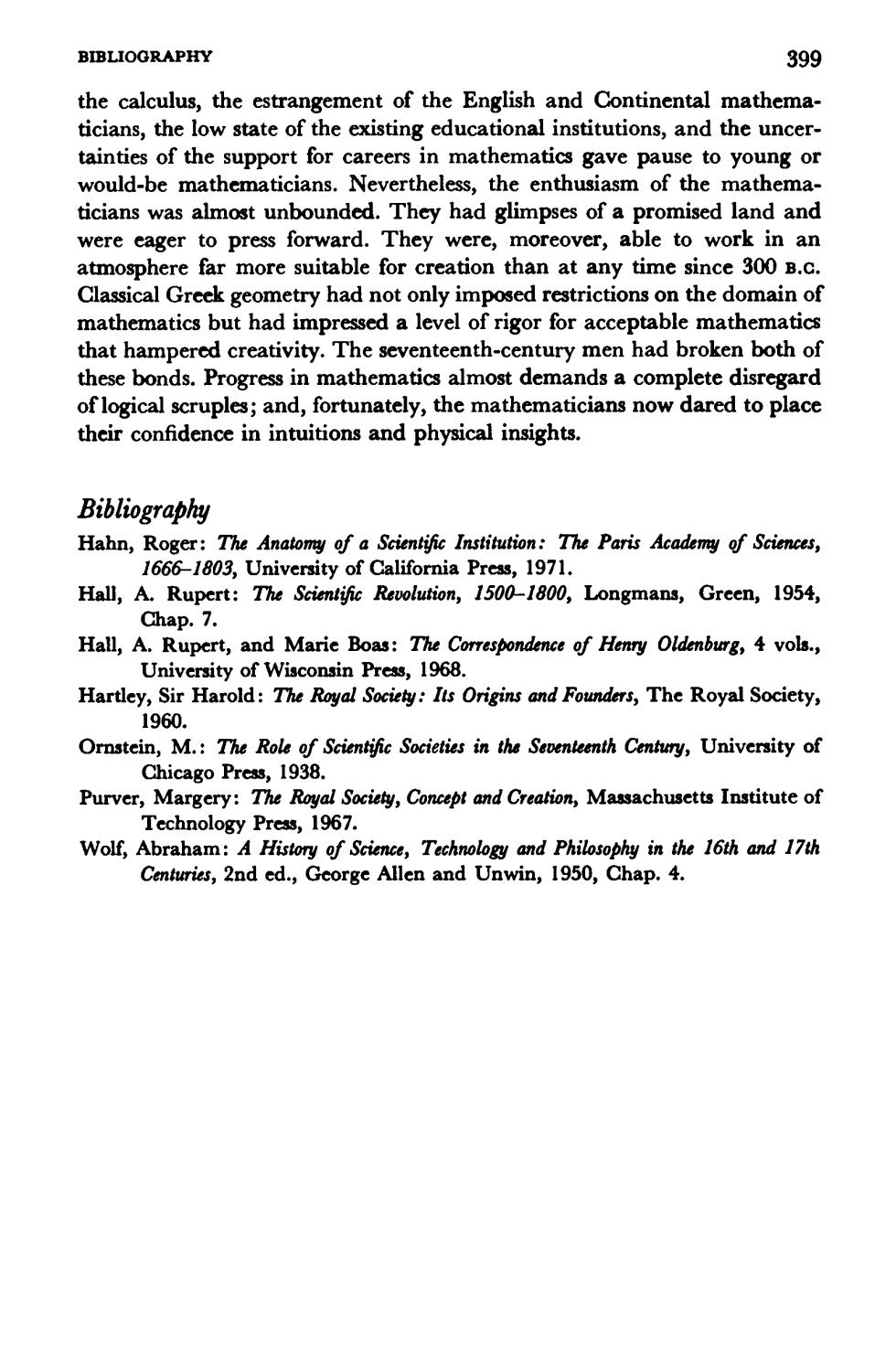
MATHEMATICS AND SCIENCE 395 Third,while the Greeks had employed mathematics freely in their science,there was,as long as the Euclidean basis sufficed for mathematics, a sharp distinction between it and science.Both Plato and Aristotle dis tinguished the two (Chap.3,sec.10 and Chap.7,sec.3),albeit in differ- ent ways;and Archimedes is especially clear about what is established mathematically and what is known physically.However,as the province of mathematics expanded,and mathematicians not only relied upon physical meanings to understand their concepts but accepted mathematical argu ments because they gave sound physical results.the boundary between mathematics and science became blurred.Paradoxically,as science began to rely more and more upon mathematics to produce its physical conclusions, mathematics began to rely more and more upon scientific results to justify its own procedures The upshot of this interdependence was a virtual fusion of mathematics and vast areas of science.The compass of mathematics,as understood in the seventeenth century,may be seen from the Cursus seu Mundus Mathematicus (The Course or the World of Mathematics)by Claude-Francois Milliet Deschales(1621-78),published in 1674 and in an enlarged edition in 1690 Aside from arithmetic,trigonometry,and logarithms,he treats practical geometry,mechanics,statics,geography,magnetism,civil engineering. carpentry,stonecutting,military construction,hydrostatics,fluid flow,hy- draulics,ship construction,optics,perspective,music,the design offirearms and cannons,the astrolabe,sundials,astronomy,calendar-reckoning,and horoscopy.Finally,he includes algebra,the theory of indivisibles,the theory of conics,and special curves such as the quadratrix and the spiral.This work was popular and esteemed.Though in the inclusion of some topics it reflects Renaissance interests,on the whole it presents a reasonable picture of the seventeenth-and even the eighteenth-century world of mathematics One might expect that the mathematicians would have been concerned to preserve the identity of their subject.But beyond the fact that they were obliged to depend upon physical meanings and results to defend their ar- guments,the greatest of the seventeenth-(and eighteenth-)century con tributors to mathematics were either primarily scientists or at least equally concerned with both fields.Descartes,Huygens,and Newton,for example, were far greater physicists than mather aticia ns.Pascal,Fermat,and Leibniz were.active in physics.In fact,it would be difficult to name an outstanding mathematician of the century who did not take a keen interest in science. As a consequence these men did not wish or seek to make any distinctions between the two fields.Descartes says in his Rules for the Direction of the Mind that mathematics is the science of order and measure and includes,besides algebra and geometry,astronomy,music,optics,and mechanics.Newton says in the Principia:"In mathematics we are to investigate the quantities of forces with their proportion consequent upon any conditions supposed;then

396 MATHEMATICS AS OF 1700 when we enter upon physics,we compare those proportions with the phe- nomena of Nature. ."Here physics refers to experimentation and obser- vation.Newton's mathematics would be regarded as mathematical physics today. 3.Communication Among Mathematicians Up to about 1550,mathematics was created by individuals or small groups headed by one or two prominent leaders.The results were communicated orally and occasionally written up in texts-which,however,were manu scripis.Since copies had also to be made by hand,they were scarce.By the seventeenth century printed books had become somewhat common,though even this improvement did not spread knowledge as widely as might be thought.Because the market for advanced mathematics was small,publishers had to charge high prices.Good printers were scarce.Publication was ofter followed by attacks on the authors from none-too-scrupulous opponents;it was not hard for such critics to find grounds for attack,especially because algebra and the calculus were not at all well grounded logically.Books in any case were not usually the answer for new creations because significant results did not warrant a book-sized publication As a consequence many mathematicians confined themselves to writing letters to friends in which they related their discoveries.Fearing that the letters would reach men who might take advantage of such unofficial docu- ments.the writers often put their results in ciphers or anagrams.which they could then decode when challenged As more men began to participate in mathematical creation,the desire for exchange of information and for the stimulus of meeting people with the same intellectual interests resulted in the formation of scientific societies or academies.In 1601 the Accademia dei Lincei (Academy of the Lynx-like) was founded in Rome by young noblemen;it lasted thirty years.Galiled became a member in 1611.Another Italian society,the Accademia del Cimento (Academy of Experiments)was founded in Florence in 1657 as a formal organization of men who had been meeting in a laboratory founded by two members of the Medici family about ten years earlier.This academy included Vincenzo Viviani(1622-1703)and Torricelli,both pupils ofGalileo among its members.Unfortunately,the society was disbanded in 1667.In Francc,Desargues,Descartes,Gassendi,Fermat,and Pascal, met privately under the leadership of Mersenne from 1630 on.This informal group was chartered by Louis XIV as the Academie Royale des Sciences in 1666,and its members were supported by the king.Paralleling what hap- pened in France,an English group centered about John Wallis began in 1645 to hold meetings in Gresham College,London.These men emphasized mathematics and astronomy.The group was given a formal charter by

COMMUNICATION AMONG MATHEMATICIANS 397 Charles II in 1662 and adopted the name of the Royal Society of London for the Promotion of Natural Knowledge.This society was concerned with putting mathematics and science to use and regarded dyeing,coinage gunnery,the refinement of metals,and population statistics as subjects of interest.Finally,the Berlin Academy of Sciences,which Liebniz had advo- cated for some years,was opened in 1700 with Leibniz as its first president. In Russia,Peter the Great founded the Academy of Sciences of St.Petersburg in1724. The academies were important,not only in making possible direct contact and exchange of ideas,but because they also supported journals. The first of the scientific journals,though not sponsored by an academy, was the Journal de Scavans or Journal des Savants,which began publication in 1665.This journal and the Philosophical Transactions of the Royal Society,which began publication in the same year, were the first journals to include mathematical and scientific articles.The french academie des sciences ini- tiated the publication Histoire de l'Acadimie Royale des Sciences avec les Mimoires de Mathematique et de Physique.It also published the Mimoires de Mathematique dans ses Assemblees.also known as the Memoires des Savants Etrangers.Another of the early scientific iournals.the Acta eruditorum.was begun in 1682 and. because it was published in Latin,soon acquired international readership. The Berlin Academy of Sciences sponsored the Histoire de l'Academie Royale des Sciences et Belles-lettres (whose title for some years was the Miscellanea Berolinensia). The academies and their journals opened new outlets for scientific communication;these and later journals became the accepted medium for publication of new research.The academies furthered research in that most of them supported scientists.For example,Euler was supported by the Berlin Academy from 1741 to 1766 and Lagrange from 1766 to 1787.The St.Petersburg Academy supt orted Daniel and Nicholas Bernoulli at various times,and Euler from 1727 to 1741 and again from 1766 to his death in 1783.The founding of academies by the European governments marks also the official entry of governments into the area of science and the support of science.The usefulness of science had received recognition. The institutions that a modern person would expect to play the major role in the creation and dissemination of knowledge- the universities- were ineffective.They were conservative and dogmatic,controlled by the official religions of the respec ive countries and very slow to incorporate new knowledge.On the whole they taught just a modicum of arithmetic,algebra, and geometry.Though there were some mathematicians at Cambridge University in the sixteenth century,from 1600 to 1630 there were none.In fact,in England during the early seventeenth century,mathematics did not form part of the curriculum.It was regarded as devilry.Wallis,who was

398 MATHRMATICS AS OF 1700 born in 1616,says of the education common during his childhood,"Mathe- matics at that time with us was scarce looked on as academical but rather mechanical-as the business of tradesmen."He did attend Cambridge University and study mathematics there,but learned far more from inde- pendent study.Though prepared to be a professor of mathematics,he left Cambridge"because that study had died out there and no career was open to a teacher of that subject." Professorships in mathematics were founded first at Oxford in 1619 and later at cambridge.prior to that.there had been only lecturers of low status The Lucasian profess orship at Cambridge,which Barrow was the first to hold,was founded in 1663.Wallis himself became a professor at Oxford in 1649 and held the chair until 1702.One obstacle to the enlistment of able professors was that they had to take holy orders,though exceptions were made,as in the case of Newton.The British universities generally (including also London,Glasgow,and Edinburgh)had roughly thesame history:from about 1650 to 1750,they were somewhat active and then declined in activity until about 1825. The French universities of the seventeenth and eighteenth centuries were inactive in mathematics.Not until the end of the eighteenth century,when Napoleon founded first-class technical schools,did they make any contri bution.At German universitics too,the mathematical activity of those two centurics was at a low level.Leibniz was isolated and, as we noted earlier, he railed against the teachings of the universities.The University of Gottin- gen was founded in 1731,but rose only slowly to any position of importance until Gauss became a professor there.The university centers of Geneva and Basel in Switzerland were exceptions in the period we are surveying;they could boast of the Bernoullis,Hermann,and others.The Italian univ were of some importance in the seventeenth century but lost ground in the eighteenth.When one notes that Pascal,Fermat,Descartes,Huygens,and Leibniz never taught at any university and that though Kepler and Galileo did teach for a while,they were court mathematicians for most of their lives, one sees how relatively unimportant the universities were 4.The Prospects for the Eighteenth Century The enormous seventeenth-century advances in algebra,analytic geometry and the calculus;the heavy involvement of mathematics in scic nce,which provided deep and intriguing problems;the excitement generated by New- ton's astonishing successes in celestial mechanics;and the improvement in communications provided by the academies and journals all pointed to additional major developments and served to create immense exuberance about the future of mathematics There were obstacles to be overcome.The doubts as to the soundness of

BIBLIOGRAPHY 399 the calculus,the estrangement of the English and Continental mathema- ticians,the low state of the existing educational institutions,and the uncer- tainties of the support for careers in mathematics gave pause to young or would-be mathematicians.Nevertheless,the enthusiasm of the mathema- ticians was almost unbounded.They had glimpses of a promised land and were eager to press forward.They were,moreover,able to work in an atmosphere far more suitable for creation than at any time since 300 B.c. Classical Greek geometry had not only imposed restrictions on the domain of mathematics but had impressed a level of rigor for acceptable mathematics that hampered creativity.The seventeenth-century men had broken both of these bonds.Progress in mathematics almost demands a complete disregard of logical scruples;and,fortunately,the mathematicians now dared to place their confidence in intuitions and physical insights. Bibliography Hahn,Roger:The Anatomy a Scimtietitution:The Paris Academy Sciemes sity of Califor mia Press,1971. Hall,A.Rupert:The Scientific Revolution,1500-1000,Longmans,Green,1954, Chap.7. Hall,A.Rupert,and Marie Boas:The Correspondence of Henry Oldenburg,4 vols., University of Wisconsin Press,1968. Hartley,Sir Harold:The Royal Sc:Is Origins and,The Royal Soccty, 1960. Ornstein,M.:The Role of Scientific Societies in the Seventeenth Century,University of Chicago Press,1938. Purver,Margery:The Royal S and Cration,Massachusetts Instituteof Technology Press,1967. Wolf,Abraham:A History of Science,Technology and Philosophy in the 16th and 17th Centuries,2nd ed.,George Allen and Unwin,1950,Chap.4